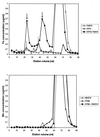Solubilization of phosphates and micronutrients by the plant-growth-promoting and biocontrol fungus trichoderma harzianum rifai 1295-22
- PMID: 10388685
- PMCID: PMC91438
- DOI: 10.1128/AEM.65.7.2926-2933.1999
Solubilization of phosphates and micronutrients by the plant-growth-promoting and biocontrol fungus trichoderma harzianum rifai 1295-22
Abstract
We investigated the capability of the plant-growth-promoting and biocontrol fungus Trichoderma harzianum Rifai 1295-22 (T-22) to solubilize in vitro some insoluble or sparingly soluble minerals via three possible mechanisms: acidification of the medium, production of chelating metabolites, and redox activity. T-22 was able to solubilize MnO2, metallic zinc, and rock phosphate (mostly calcium phosphate) in a liquid sucrose-yeast extract medium, as determined by inductively coupled plasma emission spectroscopy. Acidification was not the major mechanism of solubilization since the pH of cultures never fell below 5.0 and in cultures containing MnO2 the pH rose from 6.8 to 7.4. Organic acids were not detected by high-performance thin-layer chromatography in the culture filtrates. Fe2O3, MnO2, Zn, and rock phosphate were also solubilized by cell-free culture filtrates. The chelating activity of T-22 culture filtrates was determined by a method based on measurement of the equilibrium concentration of the chrome azurol S complex in the presence of other chelating substances. A size exclusion chromatographic separation of the components of the culture filtrates indicated the presence of a complexed form of Fe but no chelation of Mn. In liquid culture, T. harzianum T-22 also produced diffusible metabolites capable of reducing Fe(III) and Cu(II), as determined by the formation of Fe(II)-Na2-bathophenanthrolinedisulfonic acid and Cu(I)-Na2-2, 9-dimethyl-4,7-diphenyl-1,10-phenanthrolinedisulfonic acid complexes. This is the first report of the ability of a Trichoderma strain to solubilize insoluble or sparingly soluble minerals. This activity may explain, at least partially, the ability of T-22 to increase plant growth. Solubilization of metal oxides by Trichoderma involves both chelation and reduction. Both of these mechanisms also play a role in biocontrol of plant pathogens, and they may be part of a multiple-component action exerted by T-22 to achieve effective biocontrol under a variety of environmental conditions.
Figures





References
-
- Agnihotri V P. Solubilization of insoluble phosphates by some soil fungi isolated from nursery seedbeds. Can J Microbiol. 1970;16:877–880. - PubMed
-
- Asea P E A, Kucey R M N, Stewart J W B. Inorganic phosphate solubilization by two Penicillium species in solution culture and soil. Soil Biol Biochem. 1988;20:459–464.
-
- Baker R, Elad Y, Sneh B. Physical, biological and host factors in iron competition in soils. In: Swinburne T R, editor. Iron siderophores, and plant diseases. New York, N.Y: Plenum Publishing Corp.; 1986. pp. 77–84.
-
- Björkman T, Blanchard L M, Harman G E. Growth enhancement of shrunken-2 (sh2) sweet corn by Trichoderma harzianum 1295-22: effect of environmental stress. J Am Soc Hortic Sci. 1998;123:35–40.
-
- Chang Y-C, Chang Y-C, Baker R, Kleifeld O, Chet I. Increased growth of plants in the presence of the biological control agent Trichoderma harzianum. Plant Dis. 1986;70:145–148.
LinkOut - more resources
Full Text Sources
Other Literature Sources

